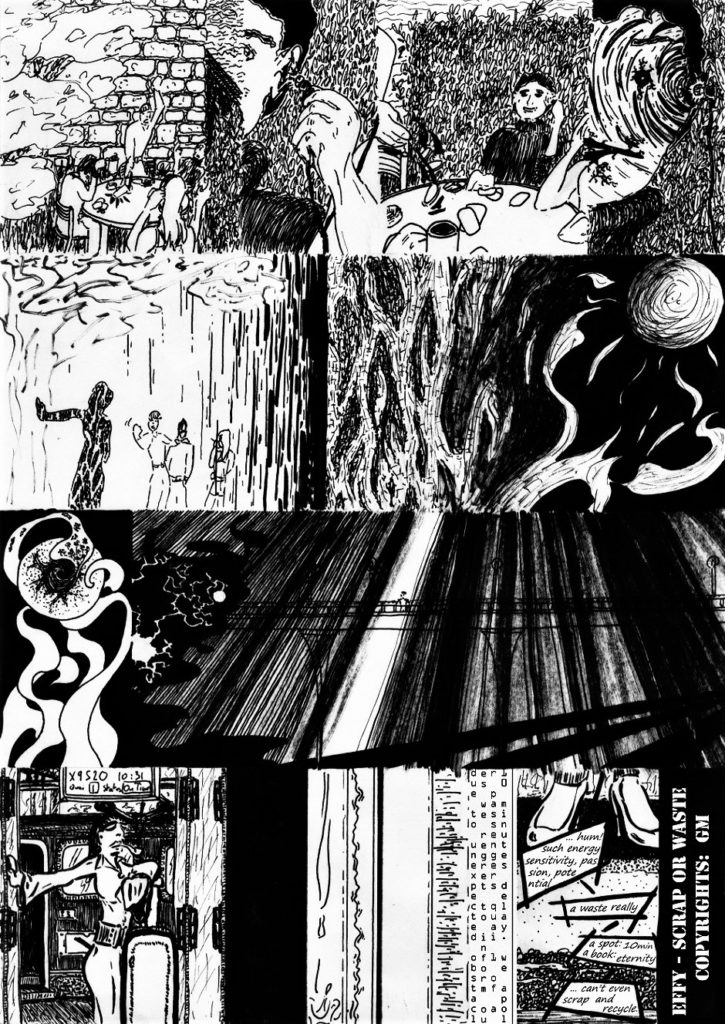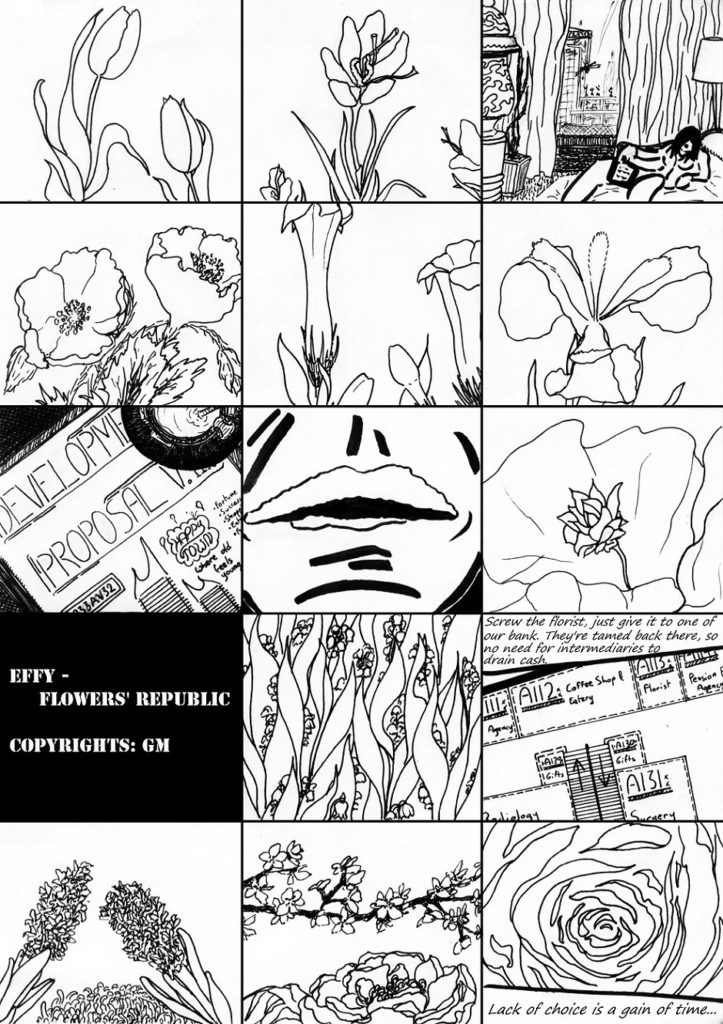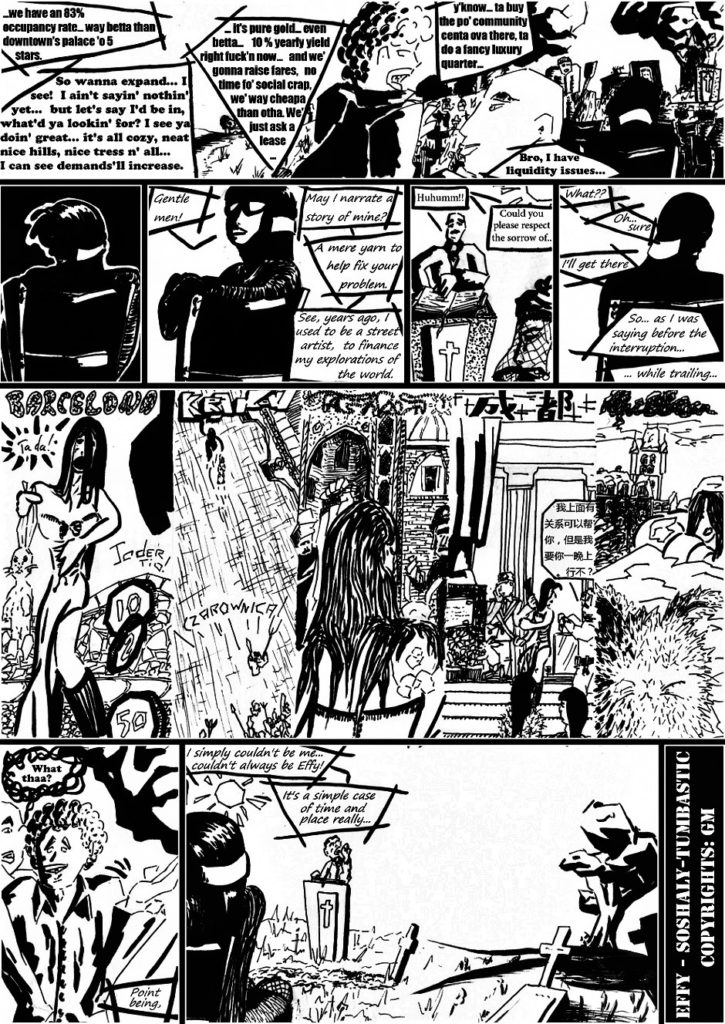Third batch of four episodes from Effy – The Living Efficiency. Suicide, Floriography, Mortuary investments, Perpetual bleeding… spring’s colorfull bliss must have passed G.M. by, as black and white surely match the creepier vibe.
Don’t miss weekly updates on Effy’s own page or through Tapas!
Most processes use a wide range of resources, all to generate the desired result. This desired result often being a valuable product or service. However, during transformation, the process will also use these resources to generate less desirable outputs. By-products, scrap, waste, and so on, the degree of non-desirability sorting them into these definitions. For example, waste has no to negative value, meaning that it cannot be used for anything worthwhile. On the other hand, scrap keeps a substantial remaining value, or usefulness.
What about human resource in all that? Processed by life, we often end up feeling crap, burn out, worn over, exhausted. Life, like most process, cares very little about the resource it employs, leaving some of us with that dire feeling of uselessness. Most of us get over it and realize how inaccurate this view is, unfortunately, some of us might sink in the feeling.
Suicide rates are very high in economically developed societies, which some people found quite ironic in itself. That’s disregarding how the life process in these societies handle its human resource. From an Effy point of view, human resources, unlike other resource, has more potential, abilities, and should never be considered waste. More like work-in-progress.
World suicide statistics:
World Health Organization: https://www.who.int/mental_health/prevention/suicide/suicideprevent/en/
World Population Review: https://worldpopulationreview.com/countries/suicide-rate-by-country/
Floriography (or the symbolism of flower) and politics have always been very preeminent in Chinese traditional arts. It’s heavily found in painting, calligraphy, ceramic, poetry, and so on. For example, a scroll displaying plum blossoms invading branches in winter, is the vehicle to narrate the great victory by a new dynasty (the plum blossom), that chases away the harsh bitterness from the previous one (winter). Flowers are brutally alive: inspiring aestheticism, invigorating scent and empowering liveliness.
I breath in, look around, and realized that even hospitals have now replaced florists by bank outlets in the halls…
Let that sink in, the reality of priorities shifting.
That is the world we’re living in, and Effy‘s investments might have played a rather large role in that. Another example are the so-called flowers revolutions that came and went, with little to no real impact. The real takeover took place though. Largest companies control more resources than most states (human, time and material), so from a leadership and decision making perspective, the mode of selection of state leaders is becoming a moot point.
You can root for A or B, eventually, Effy‘s investors win and we’re left without inspiration and beauty.
Note for non-botanists on some of the floriography found in this comics:
- Tulip Revolution (Kyrgyzstan – 2005): https://en.m.wikipedia.org/wiki/Tulip_Revolution
- Saffron Revolution (Myanmar – 2007): https://en.wikipedia.org/wiki/Saffron_Revolution
- and so on…
Further notes:
- Metropolitan Museum of Art on Chinese painting: https://www.metmuseum.org/toah/hd/chin/hd_chin.htm
- Flower Meaning page on Chinese floriography: https://www.flowermeaning.com/chinese-flower-meanings/
- Chinasage on Chinese floriography: https://www.chinasage.info/symbols/flowers-and-fruit.htm
Another one on investments following last week’s Flowers Republic. World population increases, land gets scarce, rent goes up and space becomes a luxury. That of course applies to cemeteries and death industry too, so investors cannot afford to let the trend pass them by (here an analysis for the US industry, and here is another article about designing for the dead).
In comparison, the less financially efficient land occupied by the social industry becomes the prey of savvy investments opportunities. It might be short-termist for societies to invest on the never ending life after life, instead of investing on social activities for the living, but Effy (the living efficiency) is about seizing the right opportunity, with the right resources, at the right time.
Effy decided to be metaphorical today, taking on human resource’s onboarding process and zombification!
As defined by the Society of Human Resource Management (SHRM), onboarding “is the process of integrating a new employee with a company and its culture, as well as getting a new hire the tools and information needed to become a productive member of the team.”
Well executed onboarding have several benefits such as to:
- Accelerate learning curve for newly hired employees, so that they can reach higher level of performance and productivity faster;
- Foster stable work environment, with little to no social friction thanks to clearly established norms and practices;
- Higher employee retention (up to +25% according to this article or this one) ensuring smooth work continuity and lower hiring / training costs.
To improve onboarding program’s efficiency, HR departments employ numerous strategies and methods. Some simply hand out a leaflet together with the labor contract. On the other side of the spectrum, some structure organizes fancy week-long training programs in dedicated learning centers.
A lot of academic materials on the subject is available in specialized libraries or simply online. Oddly enough, most authors overlook the issue of new employees’ own individual personality. Mostly disregarding possible conflicts with the onboarding program content. Instead, most authors focus on programs’ delivery method effectiveness, without questioning or detailing the content in depth.
Besides, effective here often translates into effectively transposing required knowledge into newly hired. The transfer of knowledge from new employees back into the organization is mostly under rated. And no, onboarding program feedback that focus on the method and not the content is not a solution.
So overall, it is a well-established practice that onboarding programs are less focused on integration, and more on assimilation, if not flat out brainwashing.
Which brings another definition. From the Medical Dictionary to mind, the one (slightly altered) of zombification: “The purported conversion […] to a state in which the awareness of an individual is retained […] while the body, lacking will or agency, becomes the slave […]. Zombification is deemed to be murder in Haiti even if the victim is manifestly still alive. The state is either induced by various poisons or by strong suggestion in a context of powerful superstitious belief.”
Effy founds her own specific way, assimilating through replacement. Sucking dry new hired of their own self to the last drop. It then becomes very easy to pour in adequate knowledge, culture and social norms into the empty shells!












